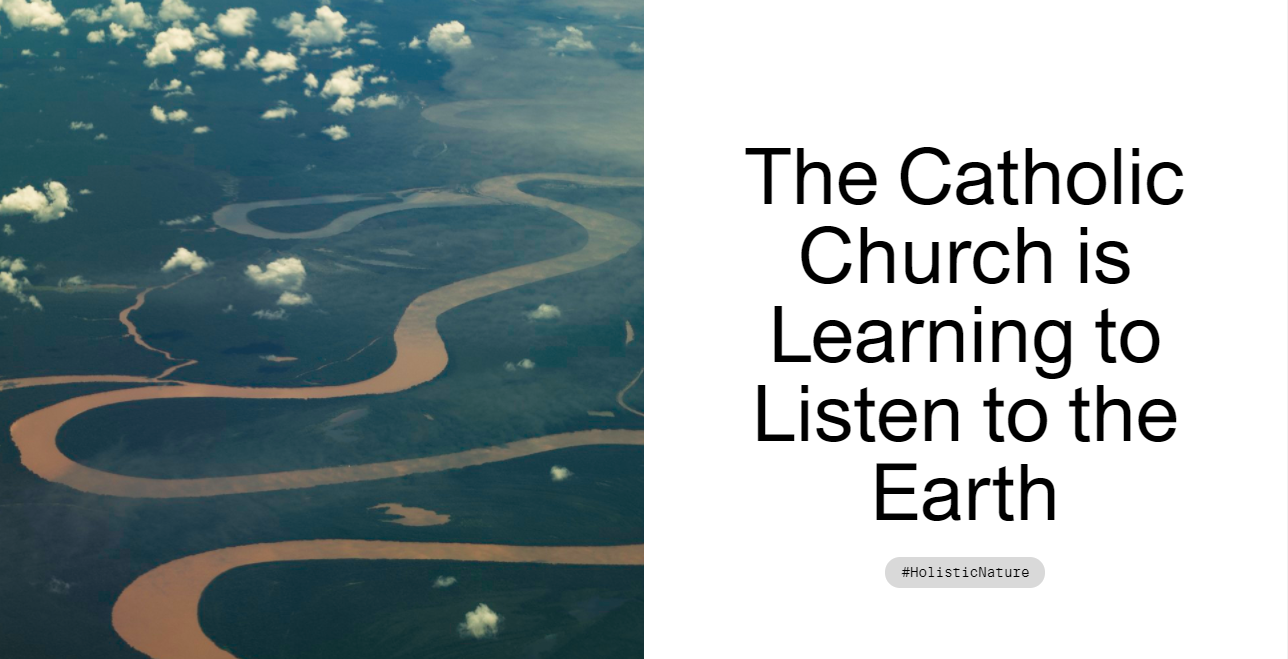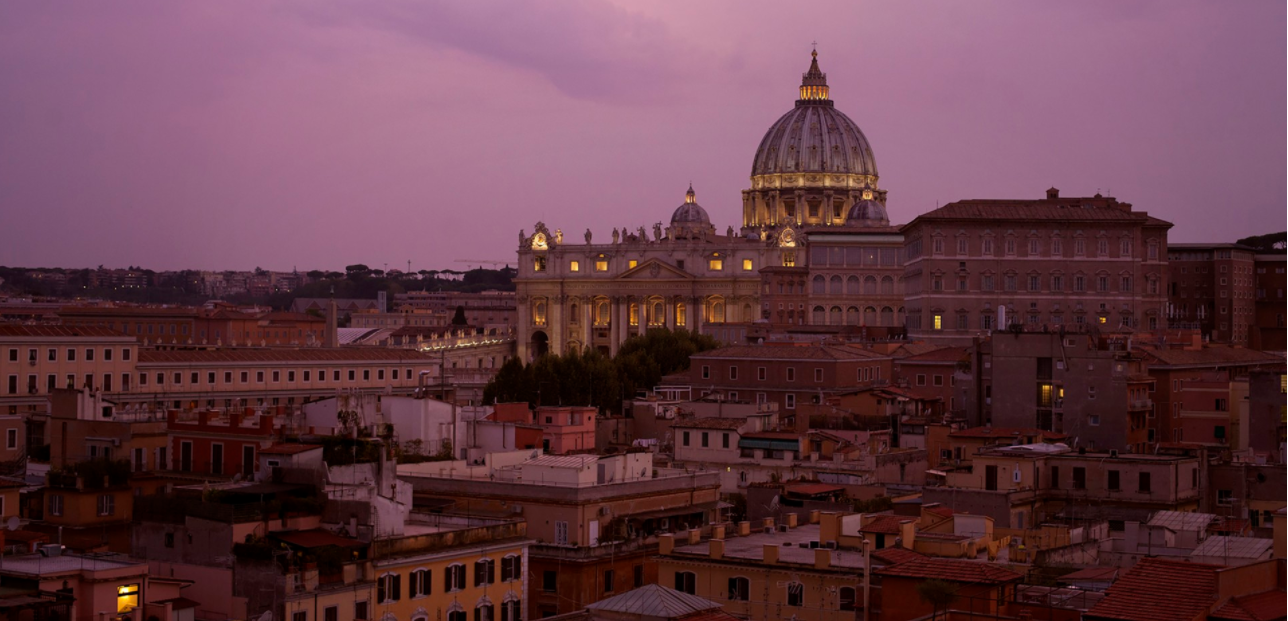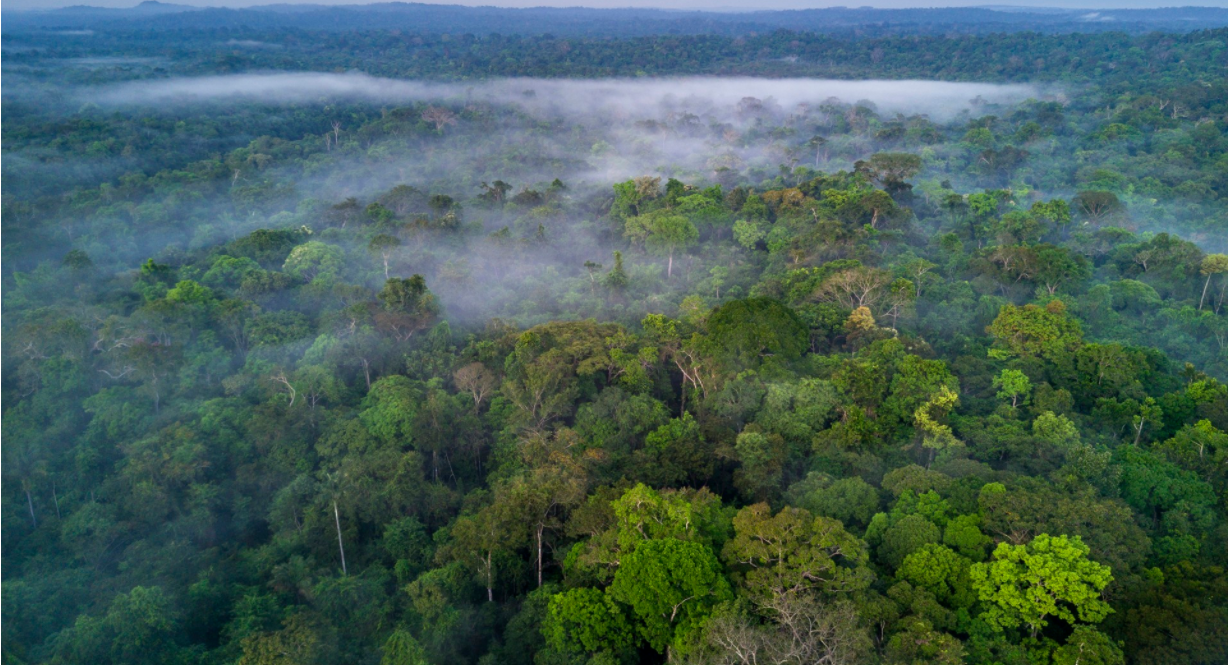Pope Francis is pushing the world’s 1.3 billion Catholics toward climate action—and looking to communities outside traditional centers of power to lead the way.
It’s hard to really “get” the Amazon if you’re not from there, according to Indigenous leader Patricia Gualinga. But she says that Pope Francis—despite all the miles that separate the Vatican from the world’s most famous rainforest—understands it in a profound way.
A leader from the Kichwa community of Sarayaku in Ecuador, Gualinga has put her life on the line to advocate for the rights of Indigenous people in the Amazon. If anyone has a right to call out the church for the ways it has historically failed to stand against or even been complicit with destructive projects of extraction and colonization that threaten life in the Amazon, it’s her.
But when asked about it, Gualinga is more likely to highlight the church’s recent championing of the region than anything else. She credits this shift largely to Pope Francis, formerly known as Jorge Mario Bergoglio, who assumed the papacy in 2013.
“The changes have been felt since the moment the pope chose the name ‘Francis,’ who within the Catholic faith is a saint who loved all creation as a work of God. [Saint Francis] spoke with nature, understood Brother Wind and Sister Rain, and had this connection to communicate with them just like our Indigenous wise men and women,” she says. “At that moment, without knowing him, I knew there would be good surprises.”
The first of those “good surprises” came in the form of Laudato Si’, an encyclical (an important church document that communicates something the Pope considers a high priority) on the environment. Laudato Si’ poetically weaves together theology, economics, and science to urge the church to take action on issues like climate change and overconsumption. Released in 2015, Laudato Si’ was the first encyclical out of the 240 that had been written since 1854 to focus solely on the environment.
Activist and writer Bill McKibben has called Laudato Si’ “the most important document about climate change in the past decade.” It’s not hard to see why: about one seventh of the world’s population identifies as Catholic and the Church owns 8 percent of land worldwide. Anything that could influence all those people to more actively work towards environmental justice would be significant indeed.
We have to realize that a true ecological approach always becomes a social approach. It must integrate questions of justice in debates on the environment, so as to hear both the cry of the earth and the cry of the poor.
According to Jesuit Father Rigobert Minani Bihuzo, the impact of the encyclical over the past five years has been “tremendous.” Hailing from the Democratic Republic of the Congo, Minani Bihuzo’s Catholicism has long been influenced by a uniquely African spirituality that he describes as “linked to the trees, the water and the moon.” But it wasn’t until Laudato Si’ was released that he saw care for the environment move into global church teachings in a significant way.
Pope Francis was far from the first pope to write or speak about the environment, Minani Bihuzo says. But the fact that he started from science, rather than sticking just to theology, is part of what differentiates him from his predecessors. It’s also what made his encyclical powerful even in the political sphere, read and referenced by Catholic leaders like U.S. President Joe Biden in addition to leaders who profess no faith at all.
“I was in France during COP25,” remembers Minani Bihuzo. “Normally, France is very proud to say they are a secular country, but the minister of the environment at that time and the president himself—all of them were quoting Pope Francis. I would not have imagined the impact [of the encyclical] would be at that scale.”
Embedded in Laudato Si’ is the idea of the interconnectedness of all things, a concept Pope Francis refers to as “integral ecology.” The document highlights in particular the idea that poverty and climate change are two expressions of the same crisis.
“We have to realize that a true ecological approach always becomes a social approach,” Pope Francis wrote in the encyclical. “It must integrate questions of justice in debates on the environment, so as to hear both the cry of the earth and the cry of the poor.”
To Father Peter Hughes, an Irish Catholic priest who’s been living in Peru for over 50 years, this means that a mandate to address environmental degradation goes to the very heart of the Christian message. Hughes subscribes to an idea from Latin American liberation theology that describes God as having a “preferential option for the poor,” meaning that, though God loves everyone, “the poor are the preferred ones of the Lord of life.” To link their plight with that of the Earth communicates that the Earth has a “preferred” place in God’s priorities, as well.
Photograph by Kathrin Ziegler/Getty Images
It’s the way that Pope Francis has taken this from a theoretical ideal to a concrete mandate to protect regions like the Amazon that has led Indigenous activists like Patricia Gualinga to consider him a “strong ally.” Hughes remembers a statement the pope made to a group of Brazilian bishops about six months into his papacy: “The priority of the church in Latin America must be the defense of the Amazon. We must do something bold and new,” he said at the time.
A few years after that, Pope Francis called for a synod focused specifically on the Amazon. This effectively communicated to Catholics all over the globe that, whether they lived in Latin America or not, the preservation of the Amazon should be their concern. Considering that the destruction of the Amazon impacts the climate and health of the whole globe, there’s scientific basis for the pope’s sentiments.
Pope Francis’s leadership on these issues has undoubtedly been important. But one of the most striking things he introduced through the Amazon synod process was a reordering of the top-down leadership style that has long characterized the church. Rather than simply gathering a bunch of powerful church figures to talk about the plight of the Amazon, the synod began with a preparation period that involved 260 “listening sessions” where Indigenous leaders and other voices on the ground were sought out for their opinions, experience and concerns. Over 80,000 voices were recorded during these sessions, and their insight and perspectives were integrated into the document discussed at the synod.
“As a church, we have no great tradition or history of listening to people,” Hughes admits. “But here the church listened in a very major way for over a year and a half on a preparation document. In that period a new term was coined: ‘la escucha,’ or ‘the listening.’ A synod is normally a delegation of bishops, but this time the pope made all kinds of exceptions and new rules so that there would be a lot of Indigenous leaders present.”
Gualinga was one of the leaders who attended and she says she was pleasantly surprised with Pope Francis’s “amazing clarity” with regards to the situation in the Amazon, as he spoke strongly against extractive industries like mining and oil drilling that threaten the region. “It’s not easy for someone not from the Amazon to defend her with such force and vehemence,” she adds. After the synod itself, Pope Francis also wrote a letter called “Querida Amazonia” reinforcing his support for the conclusions reached by the bishops at the synod. It seems likely that Pope Francis’s ability to speak eloquently on behalf of Gualinga’s homeland came from the fact that he had invested in a process that connected him to the voices of people who knew it firsthand.
The Amazon synod process was not the only time that Catholic leadership on the environment came from somewhere other than the top ranks of the Vatican. In 2015, anticipating the release of Laudato Si’ and the convening of COP21—where governmental representatives would gather to sign the Paris Agreement—the Global Catholic Climate Movement (GCCM) was launched. This organization of Catholics was created on the day that Pope Francis visited the Philippines in the wake of Super Typhoon Haiyan, which symbolized to many the present and future devastation of climate change as it killed over 6,000 people and left another 3.9 million homeless.
Pope Francis put the ecological crisis in the context of the Catholic social teaching, which is caring for each other and caring for the home that we share.
CHERYL DUGAN
ASIA-PACIFIC AND ENGLISH-SPEAKING ANIMATORS PROGRAMS MANAGER OF GCCM
Ahead of COP21, the GCCM gathered nearly one million signatures, many from the Philippines, advocating for the Paris Agreement to aim for a target of no more than 1.5 degrees of warming. According to the GCCM, this Catholic Climate Petition was the only petition explicitly calling for the 1.5 degree goal, which was enshrined in the Paris Agreement despite the fact some of the larger, more polluting countries had originally pushed for a 2 degree goal.
In other words, a bunch of lay Catholics in a tiny nation in Southeast Asia played a significant role in shaping one of the most universally-recognized climate goals in the world, the 1.5 degree limit. The Philippines, which is one of the most vulnerable countries in the world to climate change, saw a higher degree of warming as a death sentence, so citizens banded together to advocate for something more livable.
Since then, the Philippines has continued to set an example of what it might look like to put the ideas outlined in Laudato Si’ into practice. Cheryl Dugan, GCCM’s Asia-Pacific and English-speaking Animators Programs Manager in the Philippines, notes that the Filipino Bishops’ Conference has issued a pastoral letter on the climate emergency and pushed for churches to divest from fossil fuels. “You will see them on the street leading rallies fighting coal,” she says. She also points out that the Diocese of Maasin on the Filipino island of Leyte is the first Catholic diocese in the world to equip all 42 of its parishes with solar panels.
And the Philippines is just one of many nations in which Catholic churches are taking leadership on environmental issues. More Catholics live in Latin America than anywhere else on the globe, and ecclesial networks dedicated to environmental causes are blossoming there, with REPAM in the Amazon, REBAM in Central America and another brand-new network forming in the Chaco region. In Africa, Minani Bihuzo and his colleagues have started a network of their own called REBAC to protect the forest of the Congo Basin, which he describes as the “other lung of the world,” being only a bit smaller than the Amazon rainforest. And Asia and Oceania have RAOEN, which focuses on countries bordering the Pacific Ocean.
It’s clear that the reframing of environmental destruction in spiritually significant terms has been an important impetus for action. In Laudato Si’, Pope Francis put forth the idea of “ecological conversion,” which communicates that Catholics must “awaken to nature” in an experience that parallels their conversion to Christianity. The final document of the Amazon synod pushed the idea of “ecological sin,” a kind of structural wrong committed against the environment that ultimately functions as a “sin against God, against our neighbor and against future generations.”
“Pope Francis put the ecological crisis in the context of the Catholic social teaching, which is caring for each other and caring for the home that we share,” Dugan says. “That motivated many people to take action.”
These ideas have taken root and spread more effectively in some parts of the world than others. But environmental advocates are nonetheless encouraged by the fact that Pope Francis’s teachings are being integrated into a body of writings that will continue to occupy a prominent place in the Church even after a new pope is elected.
“Now, in the bank of documents of social teachings of the church, we have a number that are linked to the question of the environment,” says Minani Bihuzo. “So it will be impossible for the church to ignore it for a hundred years to come.”
Photograph by Ignacio Polacios/Getty Images
There’s still much that needs to happen for the Catholic church to fully grow into the vision that Pope Francis and grassroots church organizers have laid out, especially in the U.S. and Europe. The outgoing president of the Conference of Bishops in the United States—the country that bears the greatest responsibility for climate change, and which has both the economic resources and political clout to make a real dent in the problem—called climate change “important but not urgent” in 2019, in a statement one Catholic reporter described as “at odds not only with the science but with the pope.”
In Poland, the most Catholic nation in Europe, Laudato Si’ has had “little impact” and was even described by one local newspaper as being “anti-Polish” because it calls for a divestment from coal, which is a cornerstone of the nation’s economy. And even though leaders like Minani Bihuzo are finding concrete ways to enact Laudato Si’ in places like the Congo, he says there’s more to be done in terms of building true momentum throughout the African church.
Still, there’s plenty to be hopeful about. If the 1.3 billion Catholics living today learn to embrace Pope Francis’s environmental teachings as firmly as the church in Latin America and the Philippines have, it would change the world in unimaginable ways. In Patricia Gualinga’s mind, that would certainly be good news—which is what the Catholic “gospel” has claimed to be all along. And as far as Hughes is concerned, this kind of urgent action is the only option for Catholics who want to honor the ethic at the core of their religious tradition.
“We oppose environmental destruction because of our faith. It’s not an extra; it’s not an appendix,” he says. “It’s at the heart of the matter as believers in the God who sustains life.”





